 French Navy – Contre-Torpilleurs de 2100 tonnes. 6 built 1922-1925, in service until 1943: Jaguar, Lynx, Tigre, Chacal, Leopard, Panthere
French Navy – Contre-Torpilleurs de 2100 tonnes. 6 built 1922-1925, in service until 1943: Jaguar, Lynx, Tigre, Chacal, Leopard, PanthereWith the Chacal, we start a new development tree, the very unique “big cats” of the French Navy, the “contr-torpilleurs”. In the interwar the French Navy decided to start on a blank page towards destroyer designs, looking at what was made abroard, but devising its own classification. This resulted in a double standard, one one hand the “torpilleurs”, basically 1500t standard destroyers, and the “contre-torpilleurs”, new classes of large, 2000t+ heavy destroyers, faster and better armed, to catch and destroy enemy destroyers and act as scouts for the fleet. This was a completely new approach attempted by none at the time. However, why the Marine Nationale decided to take this approach is the subject of this article, and of the first of these large destroyers, the Jaguar class. The latter were six “predateurs” built 1922-25 and named Jaguar, Lynx, Tigre, Chacal, Leopard, Panthere, in service until 1942-43 (most were sunk in Toulon).
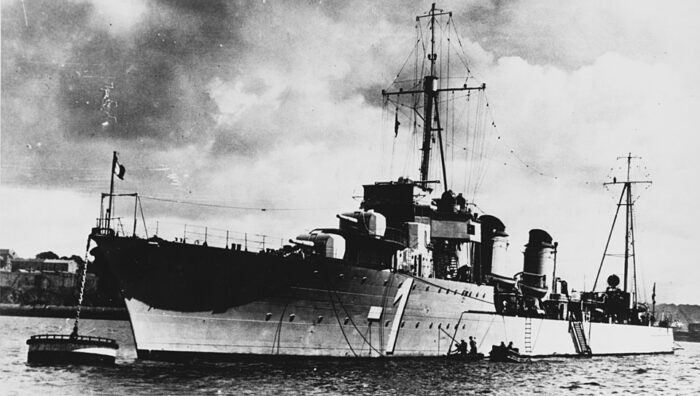
Development: Towards the “Contre-Torpilleur”
The Jaguar class destroyers marked the start of French endeavour toward a new type of destroyer, unlike anything France had built in the past. First off, the last classes in wartime were much smaller such as the Enseigne Roux (1915, 850t), Aventurier (950t), or Enseigne Gabolde (835t). It should be added that French naval construction stopped altogether due to manpower, material and resources being redirected exclusively to the land front. However after the end of hostilities in 1919, a French study of the British V-W class and of flotilla leaders such as the Scott class pointed out towards two new standards, as resumed by the general staff on its reports of new contre-torpilleurs (lit. “Counter-Torpedo Boats”). Another point that France in 1919 had a lackluster, motley collection of obsolete cruiser. The Lamotte Picquet class scout cruisers were the first planned in 1912 but budget was lacking and none was built. This left a gap in the Frencj Navy capabilities, compensated partly by war prizes (relatively modern German cruisers).
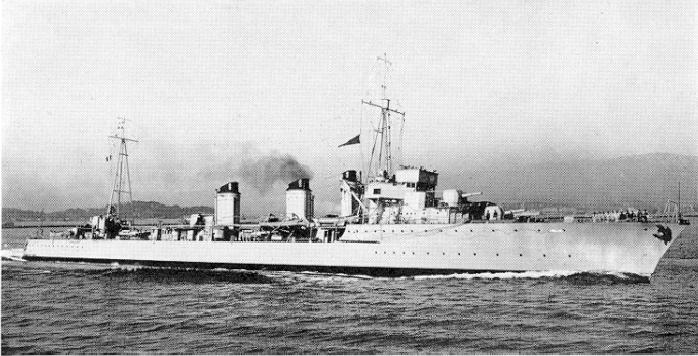
This led to define two standards to completely renew the Marine Nationale’s fleet with modern assets: The 1500 (standard) and the 2100-2500 tonnes (loosely assimilated to flotilla leaders). This framework pretty much defined the entire landscape of French destroyer from 1920 up to WW2. The Washington Treaty signed in February 1922 only confirmed the individual tonnage to reach and defined what a standard and what a leader could be. France was in a very different situation than Britain regarding destroyers however: As said above, construction of new destroyers was put on hold. The early interwar saw the retention of 1910s 440 and 850 tonners, including the 675t Japanese Kaba class purchased by France in 1917 for a total of 38 vessels plus 9 war prize destroyers. They were gradually discarded 1927-1936. Thus left time to built four classes of leaders (The Chacals, seen here, Guepard, Aigle and Vauquelin) and two classes of standards, Bourrasque and L’Adroit class.
The French flotilla leaders not called as such, “conducteurs de flottille” (the litteral translation) being seldom referenced, but “contre-torpilleurs de 2100 tonnes”. They did not appeared from the blue. During the war, the French Navy was active in the Mediterranean and Atlantic, took part in many campaigns (such as the Dardanelles) and operations and lost ships. The naval staff had the occasion to see French destroyers in action in the Adriatic against their Austrian adversaries. In 1917 a project specified a 35 knots, 3500 nm range destroyer armed with four 4.5 inches guns and six torpedo tubes, no displacement precised. Due to the conditions described above, none was laid down. However the study of Admiral Senes, a former 2500t German S113 flotilla leader certainly gave insight into these new designs.
CC profile from Maxrossomachin
In 1919 so, the Naval General Staff (NGS) decided to split the role of the destroyer: Smaller “torpilleur d’escadre” (squadron torpedo boats) would have to attack a battleline with torpedoes and defending the French line from enemy torpedo craft while the larger”contre-torpilleur” were instead scouting (replacing light cruisers) first and foremost. This required high speed in all weather, good endurance and a powerful armament to defend themselves against enemy scout cruisers.
In 1921, just as the naval treaty was discussed, the naval staff relaunched a study for a 35 knots, 3500 nm destroyer, which was to have this time five main guns and six torpedo tubes. This was the start of the “2100 tonnes” new lineage, which was approved in 1922, and a first keel laid up on 24 August 1922 (lead vessel, Jaguar) at Lorient Arsenal.

Indeed the Naval Minister initially selected a final design still “reasonable” at 1,780-metric-ton (1,750-long-ton) armed with five 100-millimeter (3.9 in) guns, which was still rejected by the French Parliament. However when giving credence to the large Italian Leone-class destroyers armed with eight 120-millimeter (4.7 in) on 2,060-metric-ton (2,030-long-ton) or theex-German destroyer SMS S113, well studied in France as whe was turned over as war reparations, armed with four 150-millimeter (5.9 in) guns, it was back to work. Th new destroyer was to even have initially six or seven of Canon de 130 mm Modèle 1919. But again the order was delayed as the negotiations during the Washington Naval Treaty took place, with tractation over destroyer tonnage and armament caliber. Ultimately six ships of the Chacal class were approved at the parliament, with the 1922 Naval Law.
Chacal-class destroyers: predators of the seas
.
The Chacal-class destroyers (Or Jaguar given their launching dates) were technological feats for their time. Built for the French Navy in the 1920s, they epitomized French naval power during the interwar period. They were a groundbreaking design: The Chacals were designed to be “destroyer killers” as much as scouts for the battleline. They wrer fast, heavily armed ships capable of engaging and sinking enemy ships of similar size. Their design was groundbreaking, with a sleek hull and powerful propulsion that allowed them to reach high speeds.
Their armament was particularly impressive for their time. They were equipped with five 130 mm guns, capable of delivering precise and powerful salvos over long distances. These guns gave them superior firepower over most opposing destroyers. A tragic fate: Unfortunately, the fate of the Chacal/Jaguar was marked by World War II. Several of them were sunk or damaged during the war. Chacal herself was sunk in 1940, after being severely damaged by German bombers.
Design of the class
Hull and general design
The Chacal were still very large destroyers for the 1920s. They had an overall length of 126.8 meters (416 ft) for a beam of 11.1 meters (36 ft 5 in), making for a 1/11 ratio, and a draft of 4.1 meters (13 ft 5 in). Displacement was 2,126 metric tons (2,092 long tons) standard but rose to 2,980–3,075 metric tons (2,933–3,026 long tons) deeply loaded. They had a double bottom under most of her length whereas the hull was subdivided into 11 transverse bulkheads making for 12 watertight compartments going up to the weather deck. The crew comprised 10 officers and 187 crewmen in peacetime, 12 officers and 209 ratings in wartime.
The design was still like a scaled-up Bourrasque class, as both designs were contemporaries. However there were a number of differences apart the scale. The Chacal class has a raised forecastle and prominent sheer and flare at the bow to ensure they remained good seaboats in all sea conditions. Later on sea trials however it was found that the forecastle buoyancy was not enough and that they were top-heavy, with poor lateral stability. Initially engineers planned 40-meter-long (130 ft) bilge keels but this proved not enough. The high lenght-to-beam was excellent for speed, but made them not maneuverable mostly due to a 14.44-square-meter (155.4 sq ft) rudder that proved to be way too small to be effective, with a too weak servomotor which speed fell down to 25–30 seconds under stress to swap from one side to another. This issue unfortunately was repeated time and again in latter designs.
Powerplant
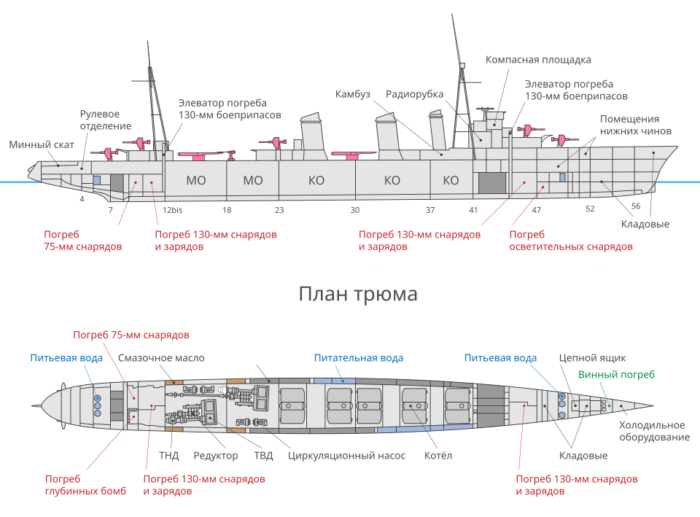
The Chacal class had a classic powerplant, with two 3.6-meter (11 ft 10 in) propellers on shafts driven by two sets of geared steam turbine each fed by steam from five du Temple boilers operating at a working pressure of 18 kg/cm2 (1,765 kPa; 256 psi) for a temperature of 216 °C (421 °F). But among all six, not all had the same turbines: Four ships were given Rateau-Bretagne turbines: Jaguar and Panthere (Arsenal de Lorient), Chacal (A C de St-Nazaire-Penhoët) and Tigre (A C de Bretagne, Nantes).
The last two both from A C de la Loire, St-Nazaire, Jaguar and Lynx, had instead two sets Bréguet geared steam turbines. These were fateful choices:
The Rateau-Bretagne were satisfactory, but initially unreliable, until teething problems were worked out. However Léopard and Lynx’s Breguet-Laval turbines were a brand new and untested design to that point, and proved very troublesome. So much so, this caused Léopard to be enter service two years late.
In both cases, the steam turbines were supposed to generate 50,000 metric horsepower (37,000 kW; 49,000 shp), unheard of for the destroyer at the time, to power them though water at 35.5 knots (65.7 km/h; 40.9 mph). The figure was initiall even 37 knots but it seemed unrealistoc for the technology of the time, ven by making the hull narrower. Then came the moment of thruthn sea trials. The turbines, depending of their types, generated from 54,850 to 57,810 metric horsepower (40,340–42,520 kW; 54,100–57,020 shp), so a bit than epxected, for a top speed also above contract, up to 36.7 knots (68.0 km/h; 42.2 mph) for an hour run on light load (meaning unrealistc conditions with no ammunition, no stocks, reduced crew, and much reduced fuel, just enough for stability).
For the range, they carried 530 metric tons (522 long tons) of fuel oil. This made for a contracted range of 3,000 nautical miles (5,600 km; 3,500 mi) at 15 knots (28 km/h; 17 mph). However again sea trials showed fuel consumption at high speed was underestimated, and was excessive, making the range plummit to 600 nmi (1,100 km; 690 mi) at 35 knots (65 km/h; 40 mph). In complement to power their fire control and weaponry when the machinery was cold, they had two 60-kilowatt (80 hp) turbo generators located in the forward engine room and two diesel generators, one of 30-kilowatt (40 hp) and another of 15-kilowatt (20 hp) in the central superstructure.
Armament
Initially in 1921-22, the main armament of the Chacal-class was optimistic with a mix of twin guns on deck and single ones on superfiring positions, making for six total, plus a 7th on a banstand amidship. This would have been a formidable, unrivalled battery, especially since they were given above average 138 mm guns as planned, approacing the punch of a 6-in guns. However not only the new planned 138 mm were nt ready yet, they were also also way too heavy. The twin mounts would have made them very unstable. In addition these twin-gun mounts as worked out, proved unsatisfactory in service. Like for Italian ships, these were compromises, with paired barrels on a single cradle so without independent elevation, and with accuracy problems but also loading issue. The initial plan was to make thel dual purpose as well but this never was meterialized due to ammunition loading issues.
In the end, the final design went for a completely austere combination of five single guns of the lighter 40-caliber Canon de 130 mm mle 1919 guns. All single mounts had light shields as protection. It was planned from the start in 1924 however, to go for the 138 mm in the next class. Indeed this was considered an obsolete gun shortly after the first ships were laid down and it was to replace them in the future by the Canon de 138 mm modèle 1923 (not yet available). But it soon appear that with their larger hoists this plan was later written off due to much more reconstruction and adaptations and the final stability way too marginal to tolerate more top weight by up-gunning the ships.
Canon de 130 mm mle 1919 (in service 1926)
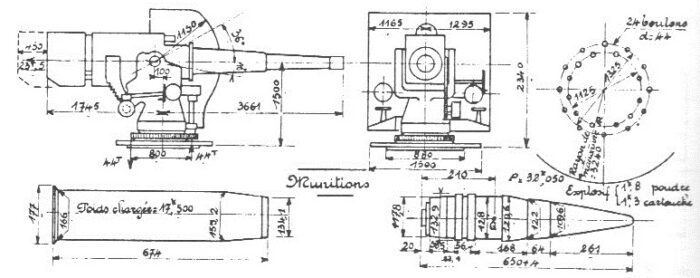
Sketch, official Robert Dumas coll. (redrawn in “French Destroyers” by Jordan and Moulin).
These five 40-caliber Canon de 130 mm mle 1919 guns in single mounts consisted of two superfiring pair fore and aft, A-B and X-Y plus a fifth gun abaft the aft funnel like most flotilla leaders. These guns were however numbered ‘1’ to ‘5’ from front to rear with their own displays from the bridge for firing control. These guns were common to the “torpilleurs” of the Simoun/Bourrasque (1,500 tonnes) classes. They could fire the SAP M1923: 70.5 lbs. (32.05 kg), HE M1923: 76.83 lbs. (34.85 kg), HE M1932: 76.72 lbs. (34.83 kg) and Starshell M1925: 70.54 lbs. (32.0 kg).
More on navweaps
⚙ specifications 130 mm mle 1919 |
|
| Weight and size | 3.35 tons, 212.8 in (5.406 m) bore 204.7 in (5.200 m) |
| Elevation/Traverse | -10° to +36°, 300° |
| Loading system | Loaded at any angle below +16°. |
| Range | 18,900 meters (20,700 yd) at 36° |
| Shell | 32.05-kg (70.7 lb) AP, MV 735 m/s (2,410 ft/s) |
| Rate of Fire | from 4 to 6 rpm |
| Capacity | 802 shells for the fore and aft pairs* |
Each mount had a ready rack holding 24 shells. No. 3 had a larger supply of 30 rounds (no ammunition hoist down to the magazines).
Canon de 75 modèle 1924 Schneider
Unlike the previous Bourrasque’s 75 mm/50 Schneider M1922 AA guns installed on the inter-TT bandstand, a field gun partly based on the surplus Canon de 75 modèle 1897 field gun as converted, they had the new Modele 1924 but same caliber and barrel.
It had a far better velocity at 850 m/s and fired 5.93 kg (13.1 lb) fixed rounds instead of separate ones, with a ceiling of 10,000 m or 11,000 yds at 90° angle. Sources diverged however as the Bourrasque only were noted as users according to navweaps.com.
Mitrailleuse Hotchkiss de 13,2 mm
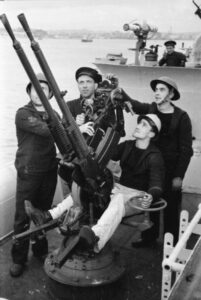 Initially the single 75 mm was completed by two 8.8 mm (0.34 in) light AA Hotchkiss machine guns located in the wings. They were removed at the same time as the “75” and replaced by two twin 13.2 mm/75 heavy machine guns. This, at least was a high rate of fire system on a light mount designed by Le Prieur. This was Gas operated system fed by 30-round box magazine, or 15-round feed strips. It was copied by Japan and Italy and used by the axis in WW2. The round was peculiar in this it was a 12.7 × 99 mm Browning (.50 BMG) cartridge necked up to 13.2 mm caliber. A short round (96 mm) was introduced in 1935. It ws mostly adopted for fixing the barrel wear issue. Hotchkiss developed also single and quad mounts, one which was studied by the US.
Initially the single 75 mm was completed by two 8.8 mm (0.34 in) light AA Hotchkiss machine guns located in the wings. They were removed at the same time as the “75” and replaced by two twin 13.2 mm/75 heavy machine guns. This, at least was a high rate of fire system on a light mount designed by Le Prieur. This was Gas operated system fed by 30-round box magazine, or 15-round feed strips. It was copied by Japan and Italy and used by the axis in WW2. The round was peculiar in this it was a 12.7 × 99 mm Browning (.50 BMG) cartridge necked up to 13.2 mm caliber. A short round (96 mm) was introduced in 1935. It ws mostly adopted for fixing the barrel wear issue. Hotchkiss developed also single and quad mounts, one which was studied by the US.
⚙ specifications 13.2mm M1929 HMG
Mass 37.5 kg (83 lbs) per gun stripped.
Length: 1.67 m (5 ft 6 in), Barrel 1 m (3 ft 3 in)
Shell: 13.2×99mm Hotchkiss Long (1929).
Elevation -10° to +90°, traverse 360°, 450 rpm cyclic, 200-250 rpm sustained
Muzzle velocity: 800 m/s (2,625 ft/s)
Max range: 7.2 km (4.5 mi), Effective 4,200 m (13,800 ft)/45°
Canon de 37mm modele 1925
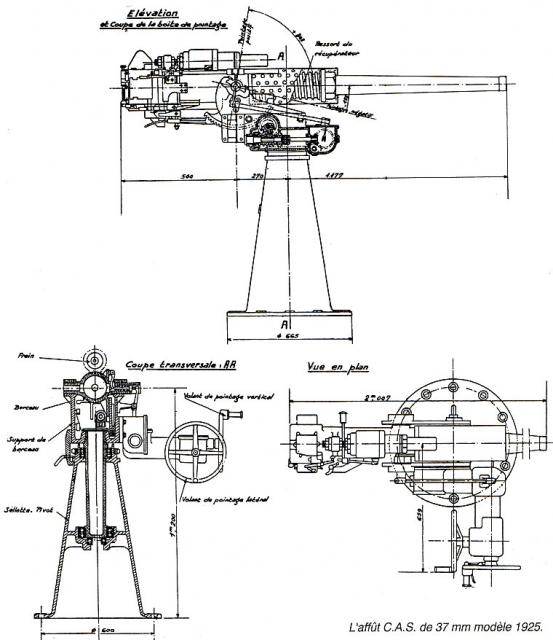
French 37 mm Modele 1925 plans
Later in their career, the Chacal class destroyers in the Vichy fleet allegedly received two 37 mm AA guns to replace their 75 mm Schneider AA guns, and were lost with them in the scuttling at Toulon in November 1942.
Mle 1919D torpedoes
These were the initial models in service with the class, used by these unusual 550 mm or 21.7 inches tubes.
Warhead: 238-kilogram (525 lb) picric-acid
Top speed 35 knots for a range of 6,000 meters (6,600 yd) or 25 knots (46 km/h; 29 mph) for 14,000 meters (15,000 yd).
1st generation postwar French torpedoes, which lackluster speed ws an issue given the top spee of the destroyers themselves. They were replaced by the modele 1923 as soon as available, ee below:
23D/DT 550mm TORPEDOES
The Toulon’s 23D model, and later 23DT were also declined for submarines as the 24V/24M.
The 23D was introduced in 1923 hence the name, “D” standing for destroyers, and DT for destroyer leaders. They were otherwise identical and intorduced a far more efficient propulsion, albeit speeds were average.
This was the standard torpedo also for cruisers, and active in WW2 albeit in 1940 was searched an Oxygen-powered model capable of 40-55 knots and up to 18 km or 19.700 yards. Developed became underground and stopped completely in 1944.

⚙ specifications 23D/DT TORPEDO
Weight: 4,560 lbs. (2,068 kg), for 27 ft. 2 in. (8.280 m) x 500 mm (21.7 inches).
Warhead: 683 lbs. (310 kg) TNT
Powered by a Schneider alcohol fed air heater, 4-cyl.
Speed settings: 9,840 yards/39 kts or 14,200 yards (13,000m)/35 kts
More
French Depth Charges
The poop featured dedicated chutes. They however had a basic hydrophone and no sonars. Thes internal chutes made the poop deck “cleaner”, protecting these from a direct hit that could have detonated these depht charges out on the open. They were dropped along guides ending short above the “beak” wwhere the poop reversed underwater. This perculiar arrangement was to avoid any return and contact with the poop. This system might have been used to lay mines of the same size by the way.
The depht charge used were the Guiraud Model 1922.
Introduced in 1923, they Weighted 573 lbs. (260 kg) for a 441 lbs. (200 kg) charge for 50 x 88 cm (19.7 x 34.6 in).
Sink Rate or terminal velocity was 10 fps (3 meters per sec.) with 100, 165, 250 and 330 feet (30, 50, 75 and 100 m) settings, later augmented to 120m.
They were held in two Galle 12-DC roller chain racks at the poop, internal, 24 total, and two depth charge throwers on the aft weather deck. Other sources specified they carried instead 20 grenades of 250 kg, so 10 per chain rack.
They also had four depth-charge throwers (“Y-Guns”) abreast the fore funnel, suppplied with a dozen smaller Guiraud Mle 1922 100-kilogram (220 lb) depth charges.
The French DC projectors were WWI Thornycroft models purchased in 1918, replaced in 1930 by the French-built 100/250 M1928 mortar. Fixed on a trainable mounting it only could project the lighter 100 kg DC at 820 feet (250 m). In the late 1930s they were replaced by a much heavier system firing 200 kg DC about 200 feet (60 m), so standardized with the 1922 Guiraud model.
However these four depth charge throwers were removed in 1932. They were badly positioned while they tended to cause leaks in the hull when used due to the concussion. Two were reinstalled still after the war started in September 1939.
The freed space and weight was reserved for two Ginocchio towed anti-submarine torpedoes, which were never used in combat.
More on this
French Sonar
Space was reserved a French sonar system cancelled in September 1930. There was a project to incorporate a passive Walser acoustic locator system but only Panthère was actually fitted. This system comprised a set of two steel lenses, one set on each side of the ship and many diaphragms amplified ambient sound for the operator. Needless to say it was only usable when static or proceeding at a very slow speed, not chasing a submarine. It was removed in 1931 but the compartment was reused for a Type 123 ASDIC system installed in 1939–40, Panthère never received it however.
Modifications
In 1931 as seen above, Panthère tested the Walser acoustic locator. As the war broke out, all had a 130mm/40 (amidship No 3) and the twin 75mm/50 to be replaced by four twin Hotchkiss 13.2mm/76 HMG, for 12 total. In 1939-1940, Jaguar, Léopard, Lynx, Chacal, Tigre had the British type 123 sonar installed.
In 1940 Léopard had a British 102mm/45 or 4 inches QF Mk V installed as well as a 40mm/39 QF Mk VIII pompom and siw extra 7.7mm/87 MGs as well as a DC stowage increased to 52.
In March 1942 she was fully converted as an escrort with a boiler and fore funnel removed, 100t of permanent ballast added, fuel stowage increased to 780t, top speed reduced to 31.5kts, she lost four twin 13.2 mm HMHs, all her 7.7mm/87 LMGs, for the addition of two single 40mm/39 QF Mk VIII pompom, four single 20mm/70 Mk II/IV Oerlikon, four new DCTs and a British radar.
By late 1943, Tigre, also used by the FFL, had all Hotchkiss HMGs removed as well as the second 550mm TT bank for the addition of two 40mm/56 Mk 1.2 Bofors and ten single 20mm/70 Mk 4 Oerlion AA guns but no radar. In April 1944, she, too, was modified as an escort, loosing a boiler and forefunnel, 100t of permanent ballast and fuel stowage to 745t, top speed down to 28.5kts and the addition of four British DCT, and radars (probably the standard 1944 Destroyer type in the RN).

Tigre in 1930 in her initial dark greay Atlantic livery

Chacal in 1939 with her Atlantic convoys livery

Leopard in FFL service after ASW escort modifications, Reunion Island Liberation
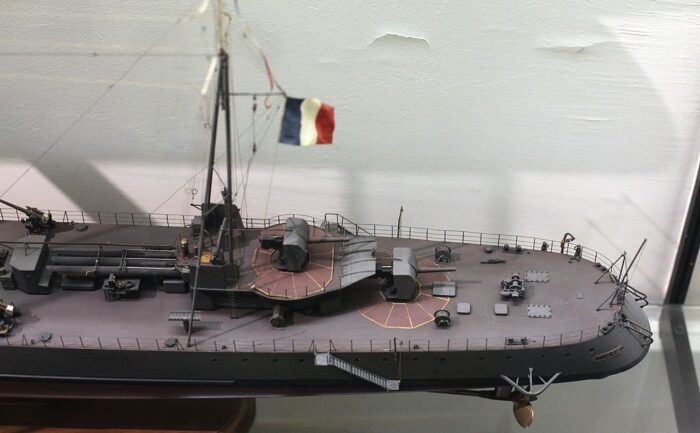
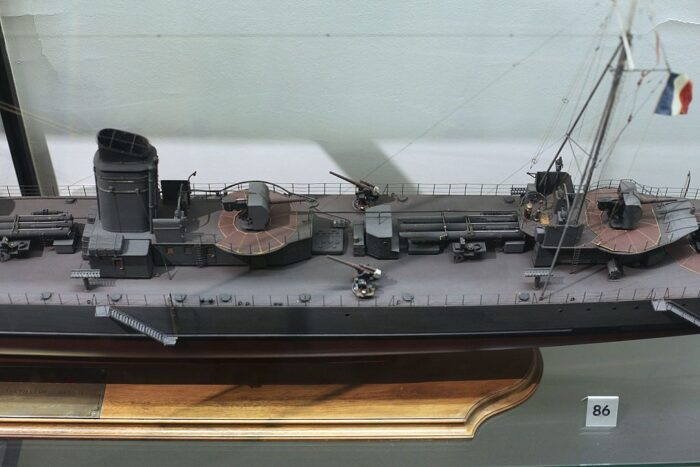
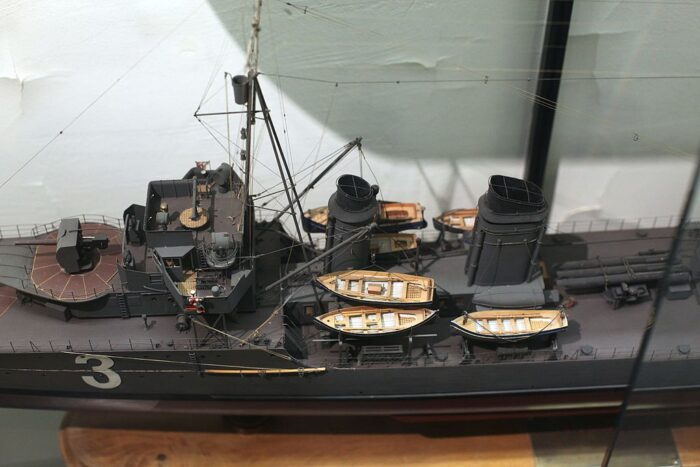

Close views of the model of Tigre as completed, Musee de la Marine, Paris.
⚙ Chacal class specs. |
|
| Displacement | 2,126 t (2,092 long tons) standard, 2,980–3,075 t full load |
| Dimensions | 126.8 x 11.1 x 4.1m (416 ft 0.1 in x 36 ft 5.0 in x 13 ft 5.4 in) |
| Propulsion | 2 shafts Geared turbines, 5 boilers: 50,000 shp (37,000 kW; 49,000 shp) |
| Speed | 35.5 knots (65.7 km/h; 40.9 mph) |
| Range | 3,000 nmi (5,600 km; 3,500 mi) at 15 knots (28 km/h; 17 mph) |
| Armament | 5× 130 mm/40, 2× 75 mm AA, 4× 13.2 mm AA, 2×3 550 mm TTs, 46 DCs |
| Sensors | Hydrophones, Radars (1942) |
| Crew | 12 officers, 209 crewmen (wartime) |
Career of the Jaguar class
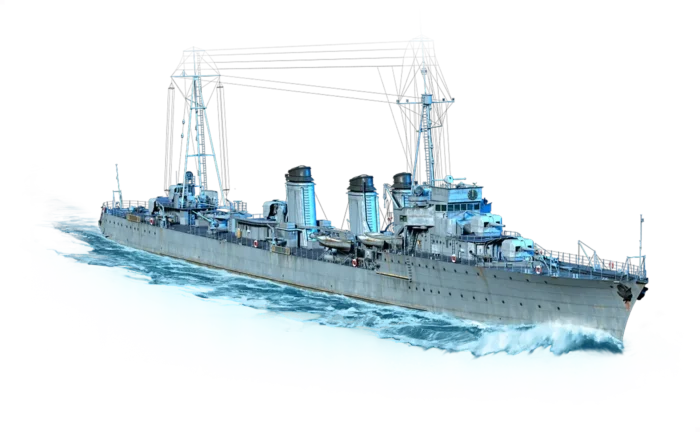
Note, most authors class these as the “Chacal class”, neither because of their laying down or launch date but alphabetical order. In france they always had been named the Jaguar class.
 Chacal
Chacal

Chacal was laid down at Ateliers et Chantiers de Penhoët, Saint-Nazaire on 18 September 1923, launched on 27 September 1924 and completed on 12 June 1926. Completion was delayed by propulsion issues as well as the late deliveries of many parts by sub-contractors. Before she was formally completed, she took part in two Baltic cruises in mid-1926 and a cruise in the Eastern Atlantic by November–December. Chacal was assigned to the 1st Large Destroyer Division or “1ère division de contre-torpeilleurs”, Mediterranean Squadron.
It was later in February 1927 renamed the 5th Light Division (Division légère), First Squadron (1ère Escadre) based at Toulon with her sister ships Panthère and Tigre. On 27 April 1927, she took part in a naval review for President Gaston Doumergue off Marseilles (He was a native of the region as well). In May 1927 she escorted hsis ship across the English Channel for a state visit to Britain until early June. She was also present for another review on 3 July 1928 off Le Havre. On 9 October 1928, Chacal, which was back to Toulon in between, sorties from Toulon with Panthère and Tigre to search for the missing submarine Ondine.
Chacal and Tigre escorted the cruiser Primauguet to French West Africa on 13 January and back on 10 April 1931. She had her four depth charge throwers removed in 1932 and joined the 9th DL, Torpedo Training School (Ecole d’application du lancement à la mer) at Toulon from 1 October until relieved in 1933. In 1934 she had her 75-mm guns replaced by twin mounts Hotchkiss 13.2-mm (0.5 in) AA. On 15 July 1935 with Léopard as part of the 8th DL, she was assigned to the Naval School (Ecole Navale) at Brest. On 12 April 1937, the 8th DL became the 2nd DCT and Jaguar joined them to form a trio in September.
By 7 September 1939, Chacal had been reassigned to the Western Command (Forces maritimes de l’Ouest), for convoy escort duties, from October to May 1940. She guarded convoys traveling between Gibraltar and Brest and Casablanca (French Morocco) or Le Verdon-sur-Mer in Southern France. In November, she received a British Type 123 ASDIC and two depth-charge throwers but lost her amidship No. 3 main gun whereas her depth charge stowage was reduced to twelve 100 kg (for the DCTs) and eight 100 kg of another model to improve stability (This was still not enough).
By 22 May, Chacal was reassigned to the 2nd DCT, carrying carry demolition teams to northernmost French ports, in prevision of a possible capture by the ports by the advancing Germans. It was necessary to sabotage all facilities in order for the Germans never to resue these. Calais was the first, with teams landing in the evening. She operated with Léopard and eight smaller destroyers, to bombard advancing German troops close to Boulogne-sur-Mer on the 23rd. But the Luftwaffe came and on the night of 23–24 May, Heinkel He 111 bombers riaded the force. Chacal was struck by a direct hits and near-misses, then lost all power. She was also supposed to have been finished off in the morning by the German field artillery. However, still afloat, with her engine power partially restored, her captain managed to have her beached between Ambleteuse and Wimereux. She was thus beached, allowed her crew to escape. The wreck was still there during the remainder of WW2.
 Jaguar
Jaguar

Jaguar was laid down at Arsenal de Lorient on 24 August 1922, launched on 17 November 1923 and completed on 24 July 1926. Completion was delayed (see above) and even before commission she took part, as a shakedown training in a Baltic cruise in mid-1926 and visited Dakar, in French West Africa in December. On April 1927 she visited Seville in Spain and the following month she took part in the escort of President Gaston Doumergue across the English Channel for a state visit. She also escort the light cruiser Lamotte-Picquet to Dakar and Buenos Aires, in June-September 1927. Back home from 1 May 1928, she became flagship of the Torpedo Boat Flotillas (1st Torpedo Boat Flotilla), 1st Squadron (1ere Escadre) at Toulon. Two months later, she hosted Doumerge, reviewing the fleet off Le Havre on 3 July.
Two years later, she took part in the naval review at Algiers, 10 May 1930 for the centenary of the first French landing in Algeria back in 1830. Her four depth charge throwers were removed two years later and then in 1934, she had the same modification as her sisters, her tw antiquated 75 mm guns were replaced by twon mounts Hotchkiss 13.2 mm HMGs. Jaguar then became flagship of the 2nd Torpedo Boat Flotilla, 2nd Squadron (2e Escadre) at Brest from 5 July 1935. She took part in many maneuvers as “flotilla leader”, adn into the combined Brest and Toulon squadrons exercises, largest French Navy manoeuvers of the interwar so far. Jaguar then took part in a naval review in the Baie de Douarnenez for then Navy Minister François Piétri on 27 June 1936. In 1937 she took part in another fleet review for the new Navy Minister Alphonse Gasnier-Duparc off Brest, 27 May. She was relieved as flagship on 26 September but resumed her former role from 1 March to 22 June 1939 as her replacement, Bison, had a collision and needed repairs.
In September 1939, she was assigned to the 2nd Large Destroyer Division (2e division de contre-torpilleur) with her sisters Chacal and Léopard. On October-December, she had two depth-charge throwers reinstalled but hr amidship main gun (#3) removed and her DC stowage reduced to save weight, due to her ongoing stability issues. She was assigned to the Western Command (Forces maritimes de l’Ouest) for convoy escort duties in October, up to January 1940. Her toute was to Gibraltar from Brest and back, including also Casablanca in Africa or Le Verdon-sur-Mer in France. On the night of 16/17 January 1940 she was accidentally rammed by the British destroyer Keppel. She lost a crewman overboard as Keppel’s bow penetrated all to her midline hull. She was still was able to reach Brest on 19 January and repairs started, which lasted until early May. She saw the installation of a British Type 123 ASDIC in March as well as degaussing equipment in April 1940.
From 10 May, her unit was transferred to the English Channel, in support of British forces and on 23 May, she entered Dunkirk with a demolition team when attacked (ambushed) underway by S-21 or S-23 S-Boote. The 21-in torpedo blasted her hull open, she had a massive flooding but her vulkhead held long enough to be later beached at Malo-les-Bains, near Dunkirk. She was written off and her hulk remained there until the end of the war. This even killed 13 men and wounded 23.
 Leopard
Leopard
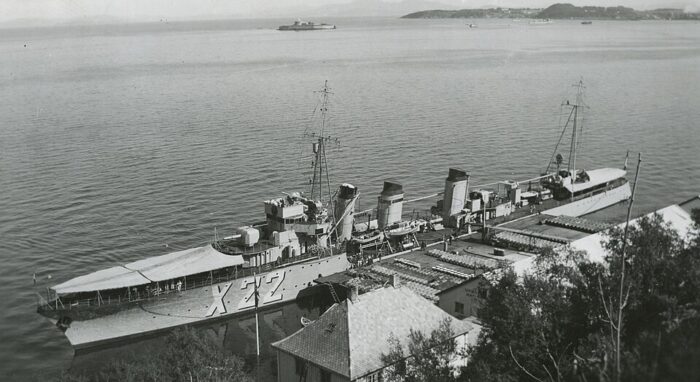
Leopard in Trondheim, 1940
Léopard was laid down at Ateliers et Chantiers de la Loire, Saint-Nazaire on 14 August 1923, she was launched on 29 September 1924 and completed on 10 October 1927. As her sisters she was delayed in completion and actually, commissioned well after, but saw service already in between. She was assigned to the 4th Light Division (Division légère), Second Squadron (2ème Escadre) at Brest upon completion, with Lynx and Jaguar. In 1932 she lost her four depth charge throwers and in 1933 took part in the fleet review for President Albert Lebrun, in Cherbourg, on 20 July. Like her sisters in 1934 she lost her 75 mm guns for twin mounts HMG AA, and on 15 July 1935, with Chacal she formed the 8th DL, assigned to the Naval School at Brest. On 12 April 1937, this became the 2nd Large Destroyer Division and they were joined by Jaguar in September.
On 7 September 1939, Léopard had been reassigned to the Western Command for convoy escort escort in October and all the way to May 1940. She traveled between Gibraltar and Brest bu also Casablanca and Le Verdon-sur-Mer. In between she receiced a Type 123, had two depth-charge throwers reinstalled, No. 3 gun removed, depth charge stowage reduced.
On 22 May she as reassigned to the 2nd DCT, bringing carry demolition teams to Boulogne-sur-Mer in the evening, and with Chacal and eight smaller destroyers she shelled advancing German troops. In fact she fired the last shots of the battle on 24 May. On 28 May, she was part of a flotilla constituted by Admiral Marcel Landriau (flagship aviso Savorgnan de Brazza) to support the evacuation of Dunkirk, Operation Dynamo. On 3 June Leopard rescued 19 British soldiers from a rescue boat (they ship was sunk).
By mid-June, Léopard defended the approaches to Cherbourg as the last strongholds fell. She sailed for Portsmouth on 19 June. She was still there, without orders but strict neutrality applied, when Operation Catapult began began on 3 July. Fortunately like most ships or submarines refuged there, there was no resistance. Under control of the British, she was eventually handed over to the Free French Naval Forces on 31 August. Command was given to Lieutenant Jules Évenou (nom de guerre “Jacques Richard”).
Commissioned with the Free French on 3 September, she waswas modified notably to modernize her to British standards and improve her stability. This was delayed as British dockyards were congested. She received a QF 4 in (102 mm) Mk V AA gun in place of her useless Hotchkiss 13.2 mm machinegun abaft the rear funnel, and those of forecastle were relocated abreast the fore funnel, while twp 2-pounder (40 mm) Mk II “pom-pom” light AA guns ended on platforms on both sides of the forward superstructure. When completed, she was assigned to convoy escort duties under RN supervision, Western Approaches. On 24 February 1941, she rescued 39 survivors from British cargo.
On 8 May 1941, she started a conversion into an escort destroyer at Kingston upon Hull. Forward boiler/funnel removed, extra oil storage and ballast added, and additional accommodation for her crew now 234 strong (in addition to extra AA crew she had a British RN liaison officer and staff). Her top speed was reduced to 31.5 knots (58.3 km/h; 36.2 mph) but now with 780 metric tons (770 long tons; 860 short tons) of oil her range jumped to 4,200 nmi (7,800 km; 4,800 mi) 234 ratings. Her poop depth charge chutes were sealed off and her stern rebuilt and strengtened to take on new two racks on the poop deck, each with twelve 251 kgs (553 lb) Mk VIIH heavy depth charges.
There were four more stored below decks. Her two depth charge thrower were replaced by four Thornycroft Mk IV and she carried for them twenty-four 191 kg (421 lb) Mk VII light depth charges. The ballasting was a measure to avoif stability issue, as well as the removal of her aft torpedo tubes. The 4-inch gun was also later replaced by a single 20-millimeter (0.8 in) Oerlikon with two more replacing the pom-poms, for extra weight saving. They replaced the former 75 mm guns positions, with another on top of the aft superstructure. Two quad Vickers 0.5 in (12.7 mm) AA HMGs were also were added on the forward superstructure. To complete this, she received on her mast a Type 291 search radar.

Leopard on 6 June 1942, camouflaged. She was the only one in her class with a proper camouflage, in FFL service.
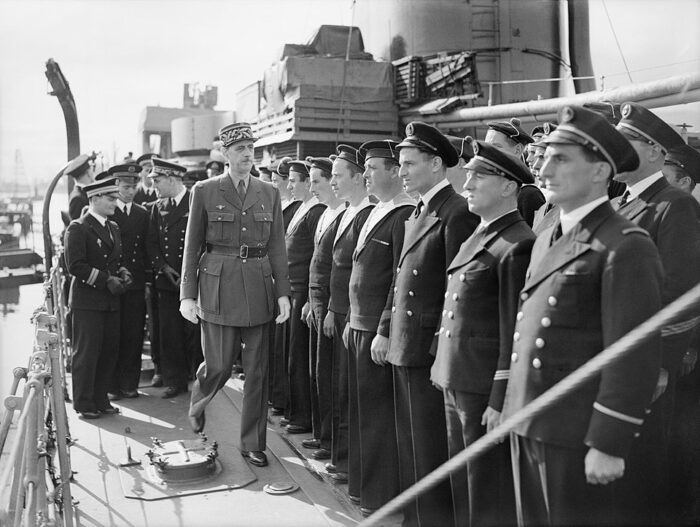
General Charles De Gaulle inspecting sailors aboard Léopard, 24 June 1942
Her convoy escort career had nothing of note, but when escorting Convoy OS33 on 11 July 1942, HMS Spey spotted U-136, surfaced, started DCs attacks after she dived and she was joined by Léopard as the sloop HMS Pelican. All three combined shared the kill. The next day Léopard collided with HMS Lowestoft, ramming her and mushing her bow. Both were repaired in South Africa in September–October. For the full escort records see uboat.net/
Liberation of La Réunion:
Léopard was selected by De Gaulle for a mission to the strategic Réunion island, near Madagascar, to convince the Vichy government there to join the Free French in June, but the collision and repairs delayed the mission to November. It happened after Operation Ironclad (the British seizure of Madagascar), a fait accomli for De Gaulle, which wanted to give the nearby island to the FFL. She was detached there in the night of 27/28 November, with 80 troops aboard. They landed, seized control of the small town of Saint-Denis (capital), but the Vichy-loyal governor fled into the interior. He gace order to resist and as soon as learning what happened, a coast-defense battery engaged Léopard. She fired back, with men killed on both sides. The Vichy pocker of reistance eventually surrendered on the 30th. Léopard remained in Indian Ocean escort convoys, until March 1943.
Léopard was then briefly refitted at Diégo-Suarez in Madagascar from 13 March to mid-April. She was transferred back to the Mediterranean, Alexandria, and from 12 May and screened a convoy to Malta. On 24 May she departed with a convoy back to Alexandria when she accidentally ran aground near Benghazi three days later. This happened while she was taken in intense axis aerial attacks which disrupted the convoy. The Allies attempted to refloat her. Divers managed to seal damaged areas between her bilges with cement, even going so far as dredging a channel back to the sea in the hours following, but weather became nasty, and the wreck eventually broke in two in the gale on 19 June. She was declared a total loss and abaondoned after inspection on 1 July.
 Lynx
Lynx
No picc
Lynx was laid down on and launched on 14 January 1924 at the same yard (Lorient), completed on 25 February 1925. She was assigned to the 4th Light Division (DL), 2nd Squadron in Brest upon completion, with Léopard and Jaguar. On 3 July 1928, she took part in the naval review by Gaston Doumergue off Le Havre and for Albert Lebrun in Cherbourg on 20 July 1933. In 1935 she was assigned to 11th DL of the Torpedo Training School. In September 1939, she was assigned to the 4th Large Destroyer Division with Panthère and Tigre. She was assigned to the Western Command for convoy escort, from October to May 1940. In January 1940 she received an ASDIC and like her sisters had two DCR reinstalled, No. 3 gun removed. She was transferred to Mers-el-Kébir in French Algeria as her sisters Panthere and Tigre, on 27 May. This was a fateful decision. She was still there on 25 June after France surrendered. On 3 July with Operation Catapult, she managed to escape the harbor and with Tigre, briefly engaged HMS Wrestler and later, detected and depth charged HMS Proteus underway for Toulon, where they arrived on the 4th. Lynx and her sisters were reduced to reserve, stripped of their AA. On 27 November 1942 as the Germans launched Operation Lila, Lynx was scuttled with the rest of the fleet to prevent capture. She was considered to be reused by the Regia Marina but never relfoated. It was the Germans which refloated her on 23 January 1944, but only to have her beached at the adjacent port of Brégaillon. The wreck was raised in 1948, ad BU.
 Panthere
Panthere

Panthère was laid down at Arsenal de Lorient on 23 December 1923, launched on 27 October 1924 and completed on 10 October 1926. On 27 April 1927, she took part in a naval review by Gaston Doumergue off Marseilles and the one on 3 July 1928 off Le Havre. On 9 October 1928 she left Toulon with Chacal and Tigre to search for the missing sub. Ondine.
With Guépard, Panthère escorted Lamotte-Picquet and Primauguet to the French West Indies (17 January-30 April 1930). She later took part in the naval review at Algiers on 10 May 1930. She was assigned to the 9th DL, Torpedo Training School at Toulon from 1 October 1932. She also received the same modifications as all her sisters.
In September 1939, she was at the 4th DCT but soon reasigned to gned to the Western Command for convoy escort until May 1940. She then started a refit at Toulon (addition of piping between the forecastle forward fuel tank to refuel at sea, removal of the mainmast for a platform with twin-gun mount 37 mm (1.5 in)). On 22 June she was not ready, with a single propeller shaft working. This was never completed and she was reduced to reserve with a skeleton crew until her non-scuttling on 27 November 1942. Indeed since her refit was never completed she was considered non-optational and no measure to scuttled her was taken. Her crew just activated the pump cocks to flood her. But she was captured almost intact by the Germans. Thus, she was turned over to the Italians on 14 December, renamed by the Regia Marina FR 22, recommissioned on 19 January 1943 after Pierre Laval agreed to the transfer on 11 January. She was at Taranto on 23 March, used as a transport in Italian waters. She saw several missions and transported Benito Mussolini from Ponza Island to La Maddalena in Sardinia on 6 August 1943. She was scuttled at La Spezia on 9 September following the armistice. She was BU after the war.
 Tigre
Tigre
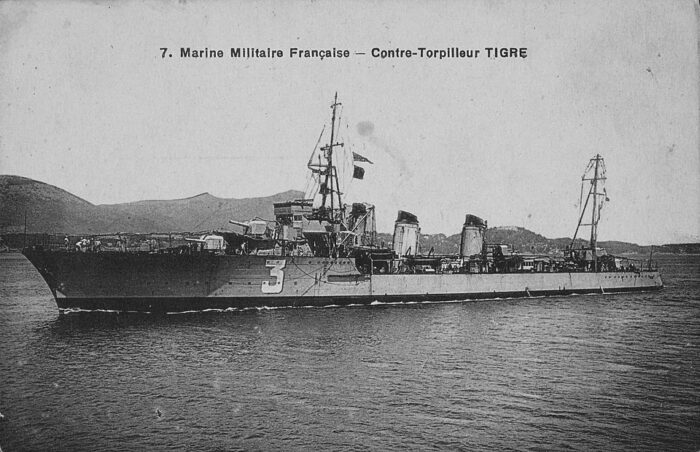
Tigre was laid down at Ateliers et Chantiers de Bretagne, Nantes on 28 September 1923, launched on 2 August 1924 and completed on 1 February 1926. She was assigned to the 1st Large Destroyer Division, Mediterranean Squadron, then 5th Light Division, First Squadron from 1 February 1927 at Toulon with Jaguar and Chacal. Tigre was assigned to the 1st Large Destroyer Division, Mediterranean Squadron (5th Light Division, 1st Squadron from February 1927) based at Toulon with Panthère and Chacal. She took part in the Nice Carniva and on 27 April to the naval review by Gaston Doumergue off Marseille, ecorting him across the Channel for a state visit bt May–June and the fleet review on 3 July 1928 off Le Havre for new Pdt. lebrun. On 9 October 1928 she took part in the search for Ondine.
Tigre and Chacal escorted Primauguet to French West Africa (13 January-10 April 1931) and was reassigned to the 9th DL, Torpedo Training School wih the modifications like her sisters. By September 1939, she was reassigned to the Western Command for convoy duties until May 1940, and last modifications. She was at Mers-el-Kébir on 3 July (Op. catapult) and briefly engaged the HMS Wrestler with Lynx and later HMS Proteus uderway for Toulon. There, she was reduced to reserve, stripped off. On 27 November 1942, she was flooded, but captured by the Germans, turned over to the Italians on 14 December. The latter recommissioned her as FR23 on 19 January 1943 after transferapproved, and started missioned from Taranto, only as transport in Italian waters. She indee wwas to be converted to Italian standards, but that was never done. She was not fully operational on 8 September 1943. Unlike other ships, she was turned over to the Free French at Bizerte in French North Africa on 28 October. Thus she was recommissioned on 15 December, but repairs at Bizerte and Casablanca, took until March 1944. She received a few extra 20 mm (0.8 in) Oerlikon light AA guns.
She then started escorting convoys in the Mediterranean until reconstructed at Oran until 3 February 1945. While in escort convoy from Corsica to Algiers, she was damaged by splinters from two near-misses on 20 April 1944 (German air raid). In Oran her forward boiler and funnel were replaced by additional oil tanks like her earlier FFL sisters, for an increased range of 4,000 nmi (7,400 km; 4,600 mi) at 13 knots (24 km/h; 15 mph) and additional accommodation, new depth charge racks and throwers to allied standards, torpedo tubes removed in compensation and final AA of 2x 40 mm Bofors, ten Oerlikon AA. She ended in the French-controlled task force “Flank Force” providing naval gunfire support for Allied forces operating near the Italian-French border (final German pockets in the Mediterranean) as well as the Allied flank against Genoa and La Spezia axis forces.
She was in Toulon by May 1945. Her cold war career was short, but she provided fire support to French forces during the riots in Algeria in June 945, then ferried troops throughout the Mediterranean until December 1946. She ended as a gunnery training ship until 9 September 1948, replaced by Albatros. She was then a stationary training ship for the Engineer School, at Saint-Mandrier-sur-Mer until stricken on 4 January 1954 and BU in 1955.
Read More/Src
Books
Brescia, Maurizio (2012). Mussolini’s Navy: A Reference Guide to the Regina Marina 1930–45. NIP.
Campbell, John (1985). Naval Weapons of World War II. Annapolis, Maryland NIP
Cernuschi, Enrico & O’Hara, Vincent P. (2013). “Toulon: The Self-Destruction and Salvage of the French Fleet”. Jordan, John (ed.). Warship 2013.
Chesneau, Roger, ed. (1980). Conway’s All the World’s Fighting Ships 1922–1946. Greenwich, UK: Conway Maritime Press.
Jordan, John & Dumas, Robert (2009). French Battleships: 1922–1956. NIP
Jordan, John & Moulin, Jean (2015). French Destroyers: Torpilleurs d’Escadre & Contre-Torpilleurs 1922–1956. Seaforth Publishing.
Smith, Peter C. (2007). Naval Warfare in the English Channel 1939–1945. Barnsley, Yorkshire, UK: Pen & Sword Maritime
Whitley, M. J. (1988). Destroyers of World War Two. Annapolis, Maryland: Naval Institute Press.
Links
on navypedia.org
on Dunkirk1940.org/
on uboat.net/
uboat.net/ chacal detailed logs
uboat.net/ jaguar detailed logs
en.wikipedia.org Chacal-class_destroyer
battleships-cruisers.co.uk chacal.htm
on commons.wikimedia.org/
Gallery
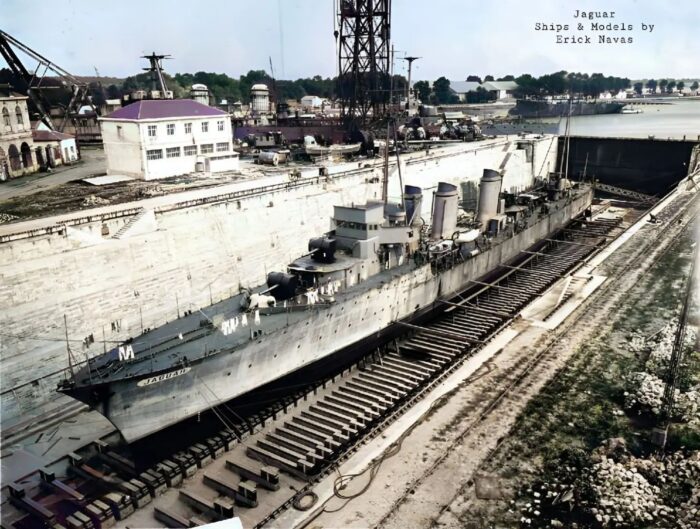
Jaguar in drydock, colorized by Erick Navas

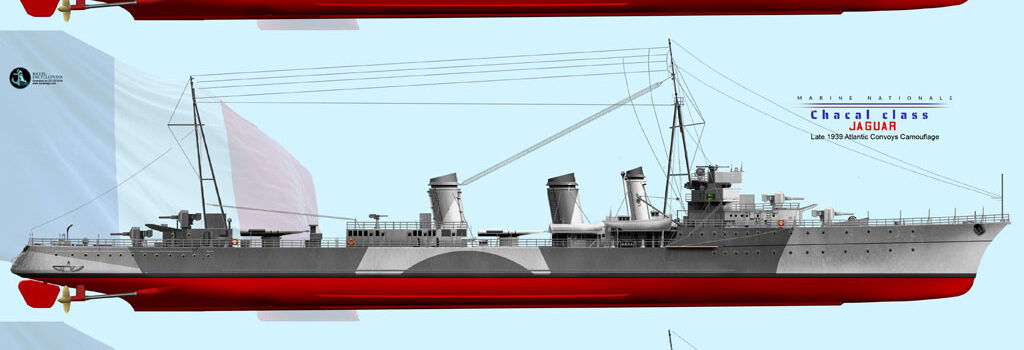
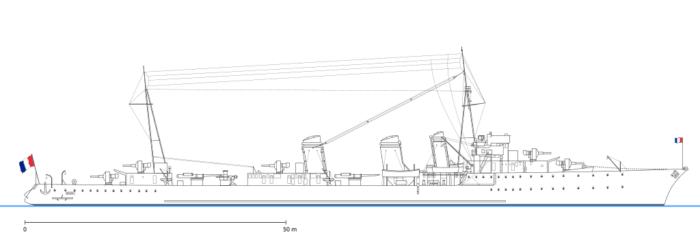

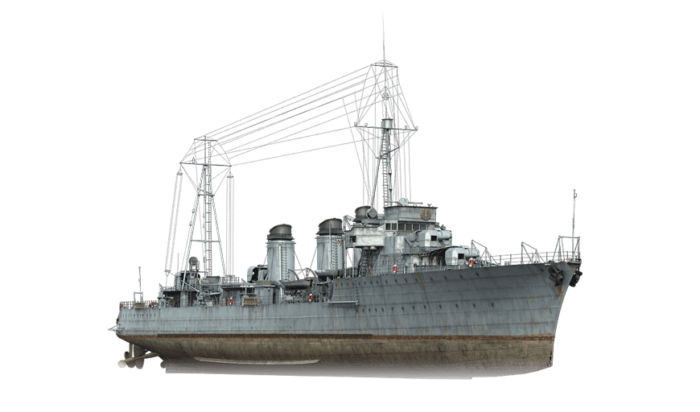


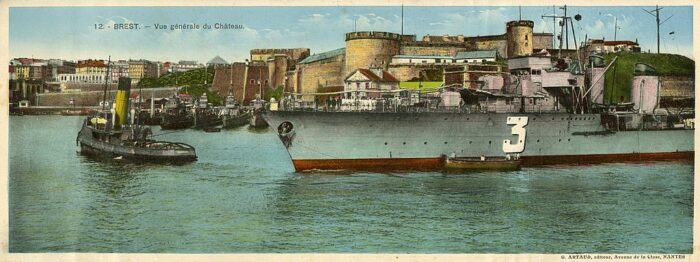
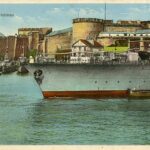
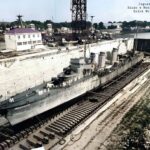
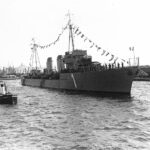
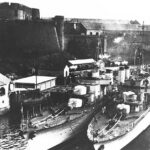
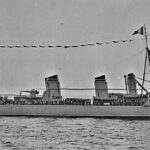
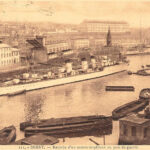
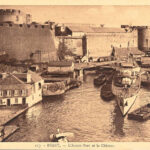
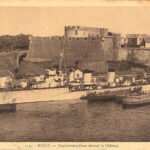

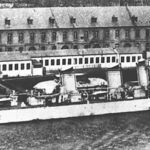

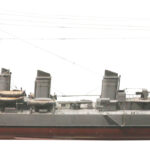
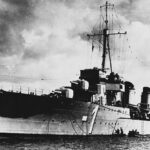
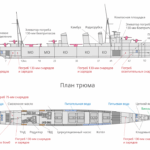
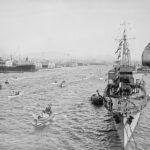
 Latest Facebook Entry -
Latest Facebook Entry -  X(Tweeter) Naval Encyclopedia's deck archive
X(Tweeter) Naval Encyclopedia's deck archive Instagram (@navalencyc)
Instagram (@navalencyc)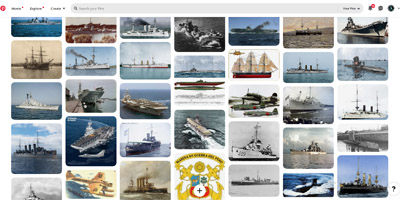

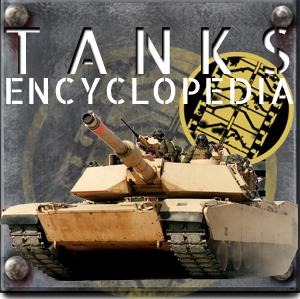
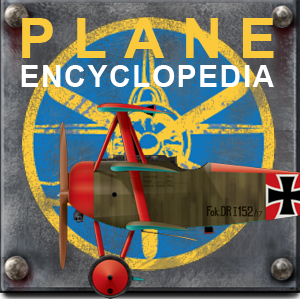
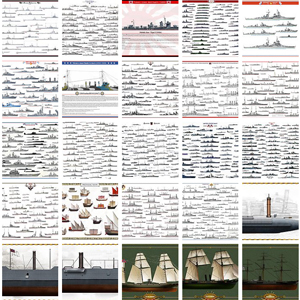
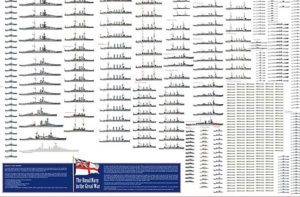
 French Navy
French Navy Royal Navy
Royal Navy Russian Navy
Russian Navy Armada Espanola
Armada Espanola Austrian Navy
Austrian Navy K.u.K. Kriegsmarine
K.u.K. Kriegsmarine Dansk Marine
Dansk Marine Nautiko Hellenon
Nautiko Hellenon Koninklije Marine 1870
Koninklije Marine 1870 Marinha do Brasil
Marinha do Brasil Osmanlı Donanması
Osmanlı Donanması Marina Do Peru
Marina Do Peru Marinha do Portugal
Marinha do Portugal Regia Marina 1870
Regia Marina 1870 Nihhon Kaigun 1870
Nihhon Kaigun 1870 Preußische Marine 1870
Preußische Marine 1870 Russkiy Flot 1870
Russkiy Flot 1870 Svenska marinen
Svenska marinen Søværnet
Søværnet Union Navy
Union Navy Confederate Navy
Confederate Navy Armada de Argentina
Armada de Argentina Imperial Chinese Navy
Imperial Chinese Navy Marinha do Portugal
Marinha do Portugal Mexico
Mexico Kaiserliche Marine
Kaiserliche Marine 1898 US Navy
1898 US Navy Sovietskiy Flot
Sovietskiy Flot Royal Canadian Navy
Royal Canadian Navy Royal Australian Navy
Royal Australian Navy RNZN Fleet
RNZN Fleet Chinese Navy 1937
Chinese Navy 1937 Kriegsmarine
Kriegsmarine Chilean Navy
Chilean Navy Danish Navy
Danish Navy Finnish Navy
Finnish Navy Hellenic Navy
Hellenic Navy Polish Navy
Polish Navy Romanian Navy
Romanian Navy Turkish Navy
Turkish Navy Royal Yugoslav Navy
Royal Yugoslav Navy Royal Thai Navy
Royal Thai Navy Minor Navies
Minor Navies Albania
Albania Austria
Austria Belgium
Belgium Columbia
Columbia Costa Rica
Costa Rica Cuba
Cuba Czechoslovakia
Czechoslovakia Dominican Republic
Dominican Republic Haiti
Haiti Hungary
Hungary Honduras
Honduras Estonia
Estonia Iceland
Iceland Eire
Eire Equador
Equador Iran
Iran Iraq
Iraq Latvia
Latvia Liberia
Liberia Lithuania
Lithuania Mandchukuo
Mandchukuo Morocco
Morocco Nicaragua
Nicaragua Persia
Persia San Salvador
San Salvador Sarawak
Sarawak Uruguay
Uruguay Venezuela
Venezuela Zanzibar
Zanzibar Warsaw Pact Navies
Warsaw Pact Navies Bulgaria
Bulgaria Hungary
Hungary

 Bundesmarine
Bundesmarine Dutch Navy
Dutch Navy Hellenic Navy
Hellenic Navy Marina Militare
Marina Militare Yugoslav Navy
Yugoslav Navy Chinese Navy
Chinese Navy Indian Navy
Indian Navy Indonesian Navy
Indonesian Navy JMSDF
JMSDF North Korean Navy
North Korean Navy Pakistani Navy
Pakistani Navy Philippines Navy
Philippines Navy ROKN
ROKN Rep. of Singapore Navy
Rep. of Singapore Navy Taiwanese Navy
Taiwanese Navy IDF Navy
IDF Navy Saudi Navy
Saudi Navy Royal New Zealand Navy
Royal New Zealand Navy Egyptian Navy
Egyptian Navy South African Navy
South African Navy






























 Ukrainian Navy
Ukrainian Navy dbodesign
dbodesign